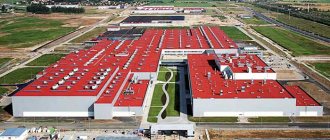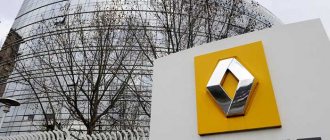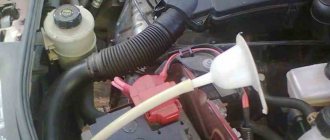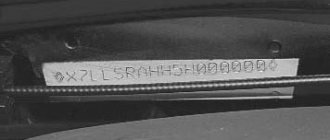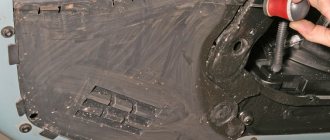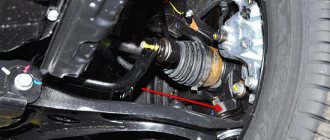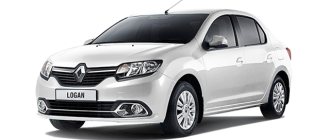The quality of car assembly at different enterprises often varies, and this also applies to Renault products.
Even though the cars are created using the same technologies and under the strict control of the company, the assembly plant is important. Let's talk about where the famous Renault Logan is produced - the symbol of the automaker.
Logan is manufactured all over the world, including in our country. Thus, the production of Renault Logan until 2015 was established at the Avtoframos plant (since 2014 Renault-Russia), after which production was transferred to the facilities of AVTOVAZ, which is part of the Renault-Nissan alliance. More details below...
2nd generation
A little about Renault production
Renault headquarters in France
Renault is more than a hundred years old and is the fourth largest concern in the world in terms of annual sales.
The manufacturer Logan achieved its success primarily through close cooperation with other concerns, in particular, it created a joint holding company with Nissan. Today Renault Logan is produced in Romania, Brazil, India, Iran and Russia.
AVTOVAZ has become a partner of the company in Russia , where they assemble Renault Logan adapted for the Russian market. Until 2015, production was located at its own automobile plant in Moscow, where popular Renault models are assembled, such as the Duster, Captur crossovers, etc. Russian-assembled foreign cars are supplied to some CIS countries.
Review of Renault Logan engines
Main Renault factories and assembly sites in the world
Renault's country of origin is France. But in Europe, labor is very expensive, and the construction of additional factories in little France will usually cost astronomical sums. Therefore, the company is pursuing other opportunities to expand. Either the plant is built in third world countries or bought by other companies in Europe. Thus, the company was able to expand its presence in the world, and most of the cheap cars coming to Russia are not assembled in France. Main factories and assembly sites for Renault vehicles:
- France - not far from Paris is the first and once main plant of the company, which serves for the development and invention of new technologies;
- Romania - the former Dacia corporation is almost entirely owned by Renault; all Romanian Dacia factories produce French cars;
- Korea: The Samsung brand is 80% owned by Renault, with many production facilities used to produce cars;
- Brazil is one of the company's largest assembly plants, supplying cars to all Latin American countries;
- Russia - for starters, Renault owns 50% of AvtoVAZ, and some models are also assembled with updated production lines.
It is worth noting such cooperation as the Renault and Nissan alliance. These are two companies that can boast of fruitful cooperation. In 2014, this alliance became the world's fourth largest automobile manufacturer. Renault owns more than 40% of Nissan shares, so today the French have almost complete control over the work and development of this company. However, the competitive environment between these brands remains, since the companies are located in approximately the same segment, each development is a potential competitor for its brother company. Despite all the difficulties, the Renault-Nissan cooperation brings many positive aspects in the exchange of technologies and the acquisition of new production capacities.
History of Renault
Assembly shop
Renault entered the Russian market at the beginning of the 20th century: cars of this brand were liked by the royal family.
Shortly before the revolution, the French company organized the Russian Renault joint-stock company and even managed to begin construction of an assembly factory in the city of Rybinsk, which was subsequently nationalized by the new government. The policy of the Soviet Union did not provide for the participation of private capital in industry, but in the 60s, Renault managed to establish technological cooperation with the USSR, making a tangible contribution to the development of the Soviet automotive industry.
"Renault Russia"
"AVTOFRAMOS" RENAULT
In 1992, Renault opened a Moscow office, and in 1998 it entered into an agreement with Moscow to organize joint production.
The new company was named “Avtoframos” (a compilation of “Automobile”, “France”, “Moscow”). In 1999, production of Renault passenger cars was opened on the basis of the AZLK plant, which had fallen into disrepair.
In 2005, the international company completed the construction of a plant in the capital, Renault began producing the Logan model. Thanks to its high reliability and affordable price, it will become the best-selling foreign car in Russia. Gradually, the concern's share in the capital of Avtoframos will increase until it reaches 100%. In July 2014, the company changed its name to Renault Russia.
Renault Logan wheels: wheel and tire sizes
Cooperation with AVTOVAZ
Production of Renault Logan at AVTOVAZ
The joint work of the international concern and AVTOVAZ began in 2008, and by 2013 Renault received a controlling stake in the Volzhsky Automobile Plant. Since then, cooperation between the two companies has only been developing. The foreign manufacturer helped AVTOVAZ overcome the crisis and modernize its workshops, at the same time increasing its influence on the Russian passenger car market.
Since 2015, Logan has also been produced at the Volzhsky plant. The new product has been a success among our drivers since the first days of sales.
Renault Logan, adapted for the Russian market, has retained the low price and best features of the previous model, while at the same time becoming even more reliable.
Quality of Russian assembly and comparison with other options
Logan is assembled in seven factories around the world, located in Romania, Morocco, Brazil, India, Iran, Colombia and Russia. This is an inexpensive car, which they decided to leave for developing countries, but the Romanian assembly began to be actively sold in Europe. Against the background of the general financial crisis, the new generation Logan was able to surpass Volkswagen in Germany in sales, which was previously impossible for other cars. The Russian assembly of the second generation Renault Logan is practically no different in quality from the Romanian one, which is considered standard. In Brazil, Colombia and other exotic countries, the company assembles Logans in old factories without much modernization, so their quality leaves much to be desired. The features of the Russian car assembly are as follows:
- Logan in our version is made of the same materials as the European version;
- On the Togliatti assembly line, the French created a complex for automatic car assembly;
- the company provided foreign inspectors and controllers who certify the quality of each stage of work;
- each automobile unit is tested before entering car dealerships;
- the cars have surprisingly high-quality internal assembly, hard plastic does not creak or crumble;
- all parts know their place, the car owner will not have any questions regarding assembly;
- The power unit and gearbox are supplied from Romania, large-scale assembly of the car is carried out at AvtoVAZ.
Despite such similar characteristics of the Russian and Romanian assemblies, different equipment is used in Russia. The engine remains the same as the first generation, but in Europe Logan is sold with 0.9 and 1.2 liter power units. The price of a car in Europe in 2012 started at 6.5 thousand Euros, which is why there are such large-scale sales in the Old World. In Logan, the manufacturer has combined several aspirations of European thinking: the desire for practicality, low price and low fuel consumption. It was these characteristics that influenced car sales in some European countries. By the way, Logan was withdrawn from European sales today.
Some numbers
Renault car plant in Moscow
We will try to present the activities of the largest plant in Russia , where Renault cars are produced today, in the form of numerical data:
- 2007 – 69 thousand cars
- 2008 – 73 thousand cars
- 2012 – 167 thousand cars
- 2015 - the millionth foreign car rolls off the assembly line, in the same year Renault withdraws Logan from production and moves it to Tolyatti
- The car plant's capacity for 2016 is 180 thousand passenger cars per year.
- Number of personnel – 2.3 thousand people
- Localization level for 2007 – 50%
- Localization level for 2022 – 70%
Renault Logan clutch replacement
Wide range of models. One homeland - many “addresses”!
Are we still talking about Renault? What models is this company ready to offer on the world market? We see that a successful project, opened in 1899 in France, gradually turned into a luxurious business that glorified the founding brothers around the world. At the moment, the popularity and level of profitability of the company is constantly increasing. Renault merged with Nissan. The two companies are merging into the largest holding. Now it is difficult to immediately answer in which country Renault produces, because cars of this brand are successfully and en masse assembled on different continents, in different countries. To find out where a car came from, you need to know the specific model.
Now Renault has also become AvtoVAZ's most influential partner. After all, Renault now owns a quarter of the shares of the largest domestic automaker.
Experts have identified several factories that produce Renault in different parts of the world.
- AvtoVAZ produces cars for Russian consumers.
- Cars from the Romanian plant are mainly supplied to the European market. There are also Romanian-assembled cars in Russia.
- Cars from the Brazilian plant no longer reach Russian motorists.
- There is another domestic plant near Moscow. A huge number of Renaults for Russia are produced here.
- Renault cars arrive in Africa, Asia, and India from a large Indian automobile plant.
Obviously, Renault is already so widespread in the world that cars are produced in different countries. The assembly location of a particular brand depends on the roads on which it is currently moving.
Where is Renault (not Logan) assembled in Russia
The Moscow Renault plant amazes with both the scale of investment in the Russian auto industry ($1.5 billion) and the degree of automation of its production.
analogues to the enterprise where passenger cars are assembled in the same quantity in our country . And today you have the opportunity to take a virtual tour of the super plant with us.
Director of the Renault plant in Moscow Jean-Louis Theron
Note! Popular Renault models are produced here, but not Logan. Its assembly was transferred to AVTOVAZ.
The car plant, where tens of thousands of cars are assembled a year, is amazing in scale. Logistics here is carried out by robotic carts that tirelessly transport goods along special magnetic tracks. There are a total of 110 such carts at the enterprise, all of them controlled from one server.
Welding of body panels is carried out by special robotic arms.
Manipulators install the panels on the stocks and then begin work. You can watch this fascinating process endlessly.
The body undergoes geometry control - at 16 thousand control points!
Not all work can yet be done by machines; there is also a place for manual labor.
The body is then sent to the paint booth.
The quality of the paintwork is checked several times.
Sometimes defects are found.
An experienced employee is responsible for finding and eliminating painting defects.
The painted bodies move further along the conveyor, where they are assembled into a car.
The speed of the line where the cars are assembled is 33.5 pcs. at one o'clock.
The company has a 5S system - sort, standardize, keep order, keep clean, make it all a habit.
There are posters everywhere reminding you of the importance of quality. The USSR immediately comes to mind.
It takes just over a day to completely assemble one car. At the end, the transport is filled with technical fluids.
Engine number, paint code and VIN Renault Logan
Brazil
The history of work in Brazil is very interesting. In fact, he has worked in this country along with the American one since 1960. But since 1970, the company left the Brazilian market. He managed to return to this country again and start producing his own cars only in 1997. Interestingly, it was in Brazil that the first Renault-Meganes were produced, which were successfully produced until 2012. Subsequently, the plant switched to production of more recent models: Sandero, Master, Logan, Duster, Capture. In 2015, the first pickup truck based on the Duster car was released. The Logan is still produced in Brazil.
Options
The 16-valve version of the Renault Logan engine is of the in-line injection type. The installation provides 4 cylinders, each with a diameter of 79.5 mm. The piston stroke is 80.5 millimeters. With a maximum possible torque of 140-150 Nm and a compression ratio of 9.5-9.8, the engine can produce from 90 to 105 horsepower. The installation runs on AI-92. Renault Logan models with the K4M engine represent the EURO 4/5 environmental class.
The 2022 Logan with this internal combustion engine in combination with a manual transmission consumes about 9.4 liters in the city, consumption in highway driving mode is 5.8 liters. The mixed cycle requires 7.1 liters per 100 kilometers.
K4M engine (front view in the direction of vehicle movement): 1 – air conditioning compressor; 2 – auxiliary drive belt; 3 – generator; 4 – power steering pump; 5 – upper cover of the timing belt; 6 – oil filler cap; 7 – absolute air pressure sensor; 8 – intake air temperature sensor; 9 – knock sensor; 10 – receiver; 11 – fuel rail with injectors; 12 – inlet pipeline; 13 – cylinder head cover; 14 – oil level indicator; 15 – thermostat housing; 16 – cylinder head; 17 – coolant pump pipe; 18 – low oil pressure indicator sensor; 19 – technological plug; 20 – flywheel; 21 – cylinder block; 22 – oil pan; 23 – oil filter
What is it for?
Today, automakers have a whole range of measures in their arsenal to ensure the safety of the body panels of their creations from the effects of corrosion, but many people are interested in whether the body is galvanized before purchasing a car, because this is excellent protection for the car.
The first option is to place as many moldings and other protective polymer panels on the body elements as possible. This allows you to secure multiple “problem areas”.
The second method is to use a special coating of the body with certain compounds. Due to this kind of preservation, the metal of the body can “live” for quite a long time.
If the future owner plans to purchase a Renault Logan, then he should not have any concerns about the durability of the bottom. At the factory, this car receives a reliable anti-corrosion coating, which allows it to withstand with enviable dignity the entire galaxy of hardships that plague Russian climatic conditions. The guaranteed period for maintaining protective properties is close to five years. Next, you will need to update the coverage.
Currently reading: Comparison of Lada Kalina 2 with Renault Logan
We've sorted out the bottom, but what can we tell you about the Renault Logan body panels? The owners have already noticed that during 5-7 years of intensive use, the wings, lower door edges, hood and trunk lid are subject to a fierce attack of the “red disease”.
The zinc protective layer, which most budget employees cannot boast of, requires its application before direct factory painting. This coating can prevent the metal surface from reacting with salt impurities and moisture. Manufacturers of such cars provide guarantees for the safety of the body against through holes for up to 10 years.
Galvanizing technology is very common among European and Japanese manufacturers, among even middle-class cars; no one cares whether the body is galvanized or not, of course, yes. Not only passenger cars, but also commercial trucks are treated with this coating.
Iran
The first cars of the Renault family were produced in Iran in 1976. At that time it was a popular Renault-5 model. Already in 2004, an agreement was signed between the presidents of Iran and Renault on the creation of joint automobile production in the country. Thus was born the Renault Pars company, specializing mainly in the production of Renault-Sandero. There are no plans to assemble Renault-Logan at Iranian factories yet.
In 2022, Renault announced the construction of a new automobile plant near Tehran. Once fully operational, the plant will be able to produce up to 15,000 vehicles per year, almost doubling production. This progress was facilitated by the lifting of sanctions against Iran by the European Union.
Price and main competitors in the market - who to look at?
For example, let's take a 2022 car that has driven about 120,000 km.
This is a very good purchase, for which you can pay up to 400,000 rubles. On the market, many sellers ask for more, but it’s not worth paying more money for this car. We will try to find competitors within the same amount. So, from the competitors it is worth highlighting the following models:
- Daewoo Gentra. If the Uzbek assembly does not bother you, you can try to take a car of a higher class. This is a more spacious car with relatively good parameters and durable engines. It has problems, but the number of them is tolerable for the price.
- Volkswagen Polo Sedan. Not a bad car with an indestructible unit, excellent gearboxes, excellent technical equipment. But be careful with the options, many cars don’t even have air conditioning, and the safety of the car is reduced due to the lack of options that are required today.
- Hyundai Solaris. A very good Hyundai is quite capable of replacing your Renault, the assembly here is much better, and the design is more interesting. But you need to carefully look at the mileage, since after 150,000 km Solaris begins to ask for a lot of money for constant maintenance and repairs. Repairing a machine is not cheap.
- Chevrolet Cruze. You can take a swing at the C-class and buy a Cruze, which has proven itself very well in Russia and received excellent reviews. Immediately pay attention to the body, which rusts very quickly; you should not buy a car older than 2022, this can become a problem.
- Chevrolet Aveo. You can find a very fresh 2021 T300 generation car for the same money. Chevrolet is assembled much better than Logan, has more reliable engines and gearboxes, and has a slightly longer service life. But the design is not an acquired taste, so you will have to include individual parameters.
Interestingly, almost all representatives of the class are reliable and quite hardy. Among them there is not a single domestic car that at this age was beyond competition. For the same money, you can aim for a new Lada Granta, but with a decent choice of car on the secondary market, you will be able to buy a much more comfortable and high-quality car with good technical parameters and good equipment.
Optical illusion
The off-road sedan is molded according to the same recipe as the hatchback. Increased ground clearance from 170 to 195 mm, off-road body kit made of unpainted plastic and larger wheels.
The face of the hatchback and sedan looks like a carbon copy. You can count the fresh touches on one hand: updated bumper, optics, radiator grille. Inside, with my eyes closed, I recognize - Logan! Same materials, same shapeless seat. But the new steering wheel is stylish and comfortable.
The most powerful engine in the line is the Nissan HR16, developing 113 hp. Even the CVT does not prevent it from accelerating the Stepway very vigorously. The most powerful engine in the line is Nissan’s HR16, developing 113 hp. Even the CVT does not prevent him from accelerating the Stepway very vigorously.
The main news is under the hood, and we’re not talking about engines.
These are still three naturally aspirated engines with a volume of 1.6 liters: 82‑horsepower (eight valves), 102‑horsepower (16 valves) and Nissan’s 113‑horsepower. The first is mated exclusively with a 5-speed manual transmission. The second is with the old 4-speed automatic.
And the most powerful now has an alternative to mechanics - a CVT! It was high time for the Logan/Sandero family to “pick up the belt”, since there is no normal automatic machine in stock.
Versions with a CVT are called City, and they have other differences. For example, the ground clearance is 20 mm less than that of similar Stepways with manual or automatic transmissions. A questionable decision, although the clearance is more than sufficient for the city. Externally, it is easy to distinguish the City by its black exterior mirrors, inscriptions on the pillars and original rims.
— These are not wheels, but hubcaps.
Can't be! I sat down and touched it: the engineer was right—the hubcaps really are! Well done, you can't tell the difference.
The Sandero trunk threshold, like the inside of the door, is still stingy in finishing. There is none in the opening - from the word “at all.” The Sandero trunk threshold, like the inside of the door, is still stingy in finishing. It is not in the doorway - from the word “at all”.
Dubstep
Exactly a year ago we had a comparative test involving the pre-restyling cross-hatch Sandero Stepway. And I remember very well how he, with a 113-horsepower engine and a 5-speed manual, fervently drove away from the 122-horsepower Vesta and the 123-horsepower Rio X-Line. Has the enthusiasm remained with the transition from the “handle” to the variator?
The combination of engine and variator is very pleasant. The X‑tronic variator quickly changes the gear ratio without forcing the engine to roar at high speeds. Those who are accustomed to hydromechanical automatic transmissions will be pleased with the D‑step function: at maximum acceleration, the variator simulates virtual gear shifts. There is zero practical benefit, but this magic is pleasant to the ears. You can even manually switch six fixed quasi-stages.
The face of the hatchback and sedan looks like a carbon copy. The main news is under the hood. The hatchback and sedan look like a carbon copy. The main news is under the hood.
Another nice feature of the continuously variable Logan and Sandero is the power steering with an electric pump instead of a belt drive. It's more economical.
But this did not affect the handling - the cars still do not indulge in instant reactions to steering turns, or love for fast turns (this applies to all cars on the B0 platform). Logan and Sandero are not reckless, but reliable and understandable - at least if you don’t take things to extreme situations when demons come out.
As soon as the tires begin to “float”, an early and outright drift of the front axle occurs, flavored with large rolls. As they say, it’s better not to let it happen.
Cars with a CVT have a ground clearance of 20 mm less than similar Stepways with a manual or automatic transmission. It is for this reason that a variator will not appear on regular Logans - otherwise their clearance will be very small. Cars with a variator have 20 mm less ground clearance than similar Stepways with a manual or automatic transmission.
It is for this reason that the variator will not appear on regular Logans - otherwise they will have very little clearance.
Having driven a lot on the City Stepways, I switched to a car with a 102-horsepower K4M engine and an ancient, like a mammoth’s beard, 4-speed DP2 automatic transmission, which once bore the index DP0. After 113 forces and a CVT, this is a disappointment. Acceleration is endlessly sluggish.
The automatic transmission, with its long and delayed shifts, drags the car through the times of the French Revolution.
And further. All cars now have improved sound insulation, which has a positive effect on the acoustic background. But the main virtue is the suspension that is optimal for bad roads. And it’s good that shocks and vibrations, which have become the hallmark of the entire B0 family, have almost disappeared with the advent of electric power steering. Sandero and Logan remained the same indestructible kings of broken roads.
Currently reading: Buy spare parts for Renault Logan in Rostov-on-Don, sale of spare parts for Renault Logan - prices, descriptions and photos on the Avto.ru website.
Specifications
Engine volume - 1.6 l Cylinder block material - aluminum, engine weight - 105 kg Number of cylinders - 4, valves - 16 Piston stroke - 83.6 mm, cylinder diameter - 78 mm Fuel - 95, compression ratio - 10.7 Engine power - 113-117 l .With. (6000 rpm)
- In modern realities and in its class, the engine is quite ordinary - no worse, but no better than its analogues. It is not the most complex, it is not demanding on gasoline, with 95 recommended by the factory, you can also use 92 (there will be no detonation, as in the VAZ 21129, when running on 92).
- The design is an aluminum cylinder block. The block is equipped with solid cast iron sleeves. Cast aluminum oil sump. An aluminum block, compared to an old cast iron one, warms up better, but cools down faster, is lighter in weight, but is less able to withstand the load and overheat. Here you have two sides of the same coin.
- There is a variable valve timing system, a phase shifter is installed on the intake shaft, and an electronic throttle valve is used.
- The timing system uses a thin chain, the stretching of which can be expected at approximately 120 thousand km. mileage The oil pump is also driven by a chain.
- The engine is clearly not designed to install LPG. It is necessary to adjust the valve clearances, but there are no hydraulic compensators. The gaps are adjusted by selecting a pusher, approximately once every 80 - 100 thousand km. mileage (and on gas - 3 times more often). Engine noise and knocking is the main sign of an imminent trip for adjustment.
- Valve adjustment is done by selecting and replacing pushers (the procedure is long and expensive, the entire cylinder head is disassembled). By the way, there are 26 standard sizes of pushers with values from 3 to 3.5 mm in increments of 0.02 mm. And selecting these 26 sizes for 16 valves is somewhat difficult (and expensive), and the corresponding equipment is not available everywhere.
- In addition, there are reviews that the H4M engine may have difficulty starting and stalls in severe frost (from -15 C). But, as practice shows, this information often comes from people who reprint from each other and have never operated this unit. I started Logan with H4M at minus 22 degrees without any questions, almost from scratch.
Find out more about the new Logan
- Renault Logan heater motor replacement
- Renault Logan remove replacement repair Fuses and Relays of mounting blocks of the engine compartment and interior of Renault Logan
- Generator bearings for Renault Logan 1.4-1.6 - replacement, catalog number, dimensions
- Renault Logan cigarette lighter does not work: reasons, repairs
- How to replace the cabin filter Renault Logan
- Bleeding the clutch Renault Duster 2 0 - Proper bleeding of the clutch for one
- Choosing a battery for Renault Logan: characteristics, original, selection service. TOP 6 best batteries for Renault Logan for 2021
- How to remove the cigarette lighter Renault Logan - My Logan
Romania
The small town of Pitesti in Romania would have remained insignificant, but in 1968 Renault burst into its life. Everything has changed since then. The company bought a controlling stake in the existing Dacia production and began producing its own cars. Now the Romanian Renault car is sold in the markets of Ukraine, Moldova and other EU countries.
The main achievement of the plant was its participation in the development of the legendary Renault-Logan car, which was very much loved by the people of Russia. Another milestone is the construction of a plant for the production of components for the subsequent assembly of cars. The plant is so large that the parts produced are shipped all over the world. In 2022, the plant where Renault Logan is assembled increased production. By the end of this year, production of 235 thousand cars is expected.
Sources
- https://NpfGeoProm.ru/ino-brendy/gde-vypuskayut-reno-logan.html
- https://gdesobiraut.com/strana-proizvoditel/renault/
- https://strelka-detector.ru/ino-brendy/gde-sobirayut-reno-logan-v-rossii.html
- https://PromkomRostov.ru/brendy/gde-sobirayut-reno-v-rossii.html
- https://VmyatynNet.ru/inomarka/reno-proizvoditel.html
- https://kvadrocikly-stels.ru/inostrannye-avto/reno-vikipediya.html
- https://moylogan.ru/reno-logan-chya-mashina-strana-proizvoditel/
- https://art4online.ru/sovety/gde-sobirayut-reno-logan.html
- https://mobile-dvr.ru/ekspluatatsiya/gde-sobirayut-reno-logan.html
- https://AutoTopik.ru/renault/1308-strana-proizvoditel.html
- https://avto-layn.ru/inomarka/gde-vypuskayut-reno-logan.html
- https://forte-drilling.ru/ino-brendy/proizvoditel-reno-logan.html
Origins
The brand owes its birth and successful development to Louis Renault, who founded it back in 1898 together with his brothers. After only two years of the company’s existence, production volumes had grown so much that it was necessary to involve more production lines in the assembly, and then an agreement was concluded with a Belgian plant, which began assembling French cars.
In addition to producing production cars, Renault also created sports cars that took part in races and brought many victories. The constant development of the company and compliance with the needs of consumers of that time allowed it to stay afloat during the First World War.
Renault taxi models Taxi La Marne even erected a monument for the prompt transportation of soldiers to the Marne River in 1914, thanks to which the French were able to win and prevent German troops from taking over the capital. In addition, Renault Freres produced aircraft engines and ships for the army, and a tank was also designed.
Renault has presented the world with not a single iconic car, and each of them has its own story. By 1929, the car brand was represented in 49 countries, which was considered a huge achievement at that time.
The Second World War caused serious damage to Renault Freres - as a result of the fighting, several factories were destroyed, Louis Renault himself was accused of assisting the Nazis and arrested, and died in October 1944. After the war in 1945, the company was nationalized by the French government and became known as Renault.
Today, the products of the Renault automobile corporation are extremely popular, including in Russia, where the production of cars of this brand is actively underway. The cooperation of the Renault Brothers with the Russian Empire marked the beginning of a long friendship that continues throughout the history of Renault, despite government reforms and changes in power in the company.
Get off the highway -
said the stern voice of the staff navigator, adding to our collection of navigational pearls. The bumpers, markings, and asphalt disappear from the road, and we finally switch the transmission washer to Lock, blocking the center clutch.
“Automatic”, I quote from the release, has been adapted for off-road work, and with the “snowflake” button you can now “roughen” the gas pedal... But I’ll just say this: if you really need an off-road “Duster”, then there is soil, sand, virgin soil for It’s not just an episode for you - take a car with a “mechanics”!
The four-speed automatic transmission has undergone a number of changes compared to the 4x2 version: gear ratios have been increased, additional air-oil cooling has appeared, and shift modes have been rebuilt.
The four-speed automatic transmission has undergone a number of changes compared to the 4x2 version: gear ratios have been increased, additional air-oil cooling has appeared, and shift modes have been rebuilt.
The four-speed automatic transmission has undergone a number of changes compared to the 4×2 version: gear ratios have been increased, additional air-oil cooling has appeared, and switching modes have been rebuilt
It will have the same suspension (with its small strokes it’s easy to hang up the Duster, but on small bumps the car behaves perfectly), the same good protection for the units, but the “mechanics” provide more traction reserve, which is so necessary off the road!
It is the custom of the French, instead of transmission gear ratios, to indicate the inverse value - speed at 1000 rpm. An all-wheel drive car with an automatic transmission will travel 9.78 km/h in first gear. With “mechanics” on a wonderful “creeping” first - 5.79 km/h.
And I also didn’t really like how easily the “automatic” jumps up on descents, refusing to slow down with the engine. To be honest, I didn’t expect any feats outside the asphalt. “Automatic” and all-wheel drive, finally happily combined in the “Duster”, serve different purposes, each in its own way enhancing the consumer properties of the car.
The 4×4 inscriptions are not at all a pity.
The 4×4 inscriptions are not at all a pity.
4×4 inscriptions are not a pity at all
Find out more about the new Logan
- Frequently asked questions - Renault official website
- Creak when turning the steering wheel Renault Logan ♥
- Which is better to choose, Renault Logan or Nissan Almera
- Clutch cable - REPLACING AND ADJUSTING the Renault Logan clutch cable - Renault Logan
- Renault Logan battery light is on - New Logan
- Renault Logan on-board computer: diagnostic program and error codes - New Logan
- Changing the oil in the Renault Logan gearbox: procedure, recommendations
- Replacing the cooling fan resistor Renault Logan 2
Advantages, disadvantages and problems
The K7J is easy to assemble and trustworthy in terms of reliability. Repairs, if necessary, will be carried out by specialists from many service centers. For installation maintenance, you can find inexpensive used parts, analogues, or new original spare parts. In addition, donor internal combustion engines can be found on the secondary market without any problems.
Despite its advantages, the motor also has a number of disadvantages.
The most important thing is low power and inefficiency. When working, I am bothered by noise and vibration. Cases of numerous non-serious malfunctions are not uncommon. Also among the disadvantages is the lack of hydraulic compensators.
A common problem for Logan units produced from factories before 2022 has been the formation of cracks in the ignition coil, which is associated with a flaw in the design of the coil. Water leaked through the cracks, which instantly led to tripling.
Sometimes the front crankshaft oil seal, valve cover and oil separator become the focus of engine oil leaks. Coolant may be leaking from under the thermostat housing.
The timing belt is reliable and is capable of extending even beyond the service life of 60 thousand km stated by regulations, however, the wedge of the pump or tension roller leads to a break in the drive. In turn, this ends with the Renault Logan engine bending the valves.
If all the requirements for routine maintenance are met, the engine life reaches 300-350 thousand kilometers, but many installations are capable of “rolling out” even 400 thousand.
Let's go! —
heard one of the authors in response to the thoughtful reasoning outlined above. - All this is correct, but now take this trunk and take it to that Duster over there! When, instead of the usual foreign test drive, Za Rulem offered to take part in driving the car to Moscow, doubts arose only about the choice of route.
In order to be on time with the material for this issue, I had to abandon the idea of coming to Russia in a Duster. We preferred one and a half thousand kilometers of Spanish-French highways and a small but indicative part of the prairies... or whatever they call it, where you drive off the asphalt.
Another sign is on the parting panel: the symbols D and 4WD LOCK.
Another sign is on the parting panel: the symbols D and 4WD LOCK.
Another sign is on the instrument panel: symbols D and 4WD LOCK
To say that the all-wheel drive Duster with an automatic transmission immediately stands out against the background of its front-wheel drive older brother is to sin against the truth. Set the mode to 2WD - and here you have the same car. Go and feel how much the gear ratios in the transmission have been changed (answer: increased by about 5%).
By the end of the second day, consumption measured at 10.2 l/100 km at an average speed of 72.9 km/h. It could have been smaller, but for this the “automatic” lacks a couple of steps. “Duster” is by no means a testing ground for new technical solutions; it tries on time-tested (read: inexpensive) units.
The trunk of the 4x4 version is 67 liters smaller because it has a higher raised floor. But the spare tire is placed directly under it, and not fastened outside in the rear overhang. Getting it out of there, much less putting it away, is a dubious pleasure.
The trunk of the 4x4 version is 67 liters smaller because it has a higher raised floor. But the spare tire is placed directly under it, and not fastened outside in the rear overhang. Getting it out of there, much less putting it away, is a dubious pleasure.
The trunk of the 4x4 version is 67 liters smaller because it has a higher raised floor. But the spare tire is placed directly under it, and not fastened outside in the rear overhang. Getting it out of there, much less putting it away, is a dubious pleasure.
When overtaking, the automatic transmission decisively shifts to a downshift, forcing the engine to howl in an attempt to accelerate the car. Alas, its efforts are lost somewhere between third and fourth gears, so the sluggish advance doesn't match the noise effects at all.
Disadvantages of the 1.4 engine
Considerable experience in operating Renault cars with all three types of liquid-cooled engines allows us to draw up a fairly objective picture of their strengths and weaknesses, and in the two models K7J and K7M these characteristics are almost identical, and only the K4M engine has significant differences due to more modern technological solutions, and which one is better is up to the buyers to decide.
Advantages of K7J and K7M:
- low cost and simplicity of engine design;
- reliability: confirmed service life is more than 400 thousand km;
- versatility and maintainability;
- ease of maintenance;
- high torque;
- good “elasticity” of engines, equal to 1.83.
Disadvantages of K7J and K7M:
- relatively high fuel consumption;
- instability of speed when idling;
- the absence of hydraulic compensators in the design, as a result - the need for constant adjustment of the valves (after 20-30 thousand km);
- “bending” of valves when the timing belt suddenly breaks;
- increased “fluidity” of crankshaft oil seals;
- poor reliability of cooling system elements;
- noisy and prone to vibration.
The advantages of the K7M model over the K7J include only an increase in maximum power by 12% and maximum torque by 11%. But the 1.6 liter internal combustion engine also pays for these advantages with an increased appetite of 4.5%, so which is better is a moot point.
Advantages of K4M:
- reliability, practical service life exceeds 400 thousand km;
- compliance with Euro-4 environmental standards;
- increased power (102 hp);
- low noise and vibration resistance;
- more modern and reliable cooling system.
Currently reading: How to remove carpet on a Renault Logan
Compared to 8-valve engines, the K4M 16V is much quieter, vibration-free and has the same service life, but significantly more power and torque.
Disadvantages of the K4M motor:
- expensive spare parts;
- “bending” of valves when the belt breaks;
- weak “elasticity” of the engine, equal to 1.53, as a result – problems with car acceleration when overtaking.
Thus, a detailed analysis of the technical characteristics of all three ICE samples, as well as practical experience in operating Renault Logan with these power plants, allows us to determine which engine is better. The more powerful 1.6 liter internal combustion engine with liquid cooling is still somewhat preferable to its “big brother” 1.4 liter.
Power 75 hp It’s simply not enough for comfortable driving of a loaded car, either on a country highway or during short “jogs” around the city. And in the debate between a 16V motor and an 8V motor, the first sample is the undisputed leader. The only characteristic in which 16V is inferior to its opponent is “elasticity”.
This unit has the factory index K7J, is petrol and is the first in the Renault Logan line. The remaining 1.6-liter power units are only further improvements in the design of this engine by increasing the piston stroke and engine displacement.
- the power unit has 4 cylinders and 8 valves, that is, 2 valves per cylinder, the cylinder arrangement is vertical, in-line;
- The timing drive is carried out from a toothed belt.
The declared resource of the unit is 200,000 kilometers, but many motorists easily managed to overcome this mark. There are known cases of reaching a mileage of 400,000 kilometers without major repairs.
This is due to a torque of only 115 Newton meters, due to the rather archaic design of the 1.4 unit. However, the low dynamics are compensated by moderate fuel consumption for this modification and its model year and good indicators of engine reliability and service life.
The main advantages of the Renault Logan 1.4 unit include:
- High maintainability of main components and parts. This is due to the simplicity of the design, the availability of spare parts and ease of repair. Since the power unit was designed in the 90s, it does not have complex electronic systems or complex solutions, so in many cases repairs can be made by the car owner himself.
- Maintenance, due to the simplicity of the design, is carried out by carrying out basic procedures that do not require special knowledge and skills. In this way, this Renault Logan engine differs favorably from many modern “brothers”, where the complex design will not allow the owner to carry out independent maintenance outside of service.
- Good traction capabilities of Renault Logan at low speeds. This indicator is called engine elasticity 1.4. This engine pulls well from low speeds, which in urban conditions creates more advantages and contributes to comfortable driving.
- High service life of the main components and the structure as a whole. Based on practical experience, many car owners were able to overcome the lifespan of the 1.4 engine declared by the factory without much difficulty. The great popularity of Renault Logan in taxi companies is only confirmation of this. On the roads you can find cars from the first years of production that have traveled more than 400,000 kilometers without major repairs or serious intervention in the design.
Disadvantages and most common malfunctions of the 1.4 motor:
- Imperfection of individual components and assemblies, leading to certain difficulties in the future. This is caused by the archaic nature of the design and, if during maintenance this factor is a positive feature, then when breakdowns occur it is already considered a disadvantage.
- When the timing belt breaks, damage to the engine valves occurs due to a collision with the pistons. This drawback is caused by the design of the pistons and the entire system and is a fairly significant drawback, since replacing the valves will require significant financial costs from the owner.
- Often, when the engine is idling, vibrations occur and the engine shakes. This is also caused by non-optimal fastening of the unit inside the engine compartment and the operating characteristics of the engine. This deficiency can also cause unstable idle speed. You can eliminate the situation when the engine is shaking and vibrations in car services by adjusting the engine and replacing its cushions (supports).
- Compared to modern engines, fuel consumption is quite high. Yes, in the 90s, consumption per 100 km/h in the combined cycle of around 8 liters was quite economical for a gasoline engine, but now this is unreasonably high, given the modest engine power.
- The lack of engine hydraulic compensators also entails adjusting the valves every 15,000 kilometers, which leads to additional financial costs for servicing the resource.
- Presence of high acoustic noise. When developing this Renault Logan engine, acoustic comfort was the last thing we thought about, and thus the engine turned out to be very noisy.
Engines
| Version | Working volume | Valve mechanism | Maximum power | Max. cool. moment | Acceleration 0-100 km/h / Max. speed | Fuel consumption (EU) | Notes |
| 1 16v | 998 cm³ | 16-cl., DOHC | 76 hp (56 kW) / 5,850 rpm | 97 Nm / 4,350 rpm | 14.3 s / 160 km/h | n/a | Brazilian version |
| 1.4MPi | 1,390 cm³ | 8-cl., SOHC | 75 hp (55 kW) / 5,500 rpm | 112 Nm / 3,000 rpm | 13 s / 162 km/h | 9.2/5.5/6.8 l/100 km | |
| 1.6 MPi | 1,598 cm³ | 8-cl., SOHC | 90 l. With. (64 kW) / 5,500 rpm | 128 Nm / 3,000 rpm | 11.5 s / 175 km/h | 10/5.7/7.2 l/100 km | |
| 1.6 16v | 1,598 cm³ | 16-cl., DOHC | 102 l. With. (75 kW) / 5,750 rpm | 145 Nm / 3,750 rpm | 10.5 s / 180 km/h | 9.4/5.8/7.1 l/100 km | |
| 1.5 dCi | 1,461 cm³ | 8th grade | 70 l. With. (50 kW) / 4,000 rpm | 160 Nm / 1700 rpm | 15 s / 158 km/h | 5.8/4.1/4.7 l/100 km | Not supplied to Russia |
| 1.5 dCi | 1,461 cm³ | 8th grade | 85 l. With. (63 kW) / 3,750 rpm | 200 Nm / 1,900 rpm | 13 s / 167 km/h | 5.3/4.2/4.6 l/100 km | Not supplied to Russia |
The liter engine offered in Brazil can run on either gasoline or ethyl alcohol, or a mixture of both. When running on alcohol, engine power increases to 77 hp, torque - up to 99 Nm; acceleration to 100 km/h is reduced to 14.1 seconds, top speed increases to 161 km/h.
1.6-liter 8-valve engine EURO-2 with a power of 90 hp, EURO-3 87 hp, EURO-4 84 hp, EURO-5 82 hp.
The 1.6-liter 16-valve engine is shown in some sources with 105 hp. (77 kW) and a maximum torque of 148 Nm / 3750 rpm, but the PTS of cars manufactured in the Russian Federation indicates 102 hp.
The engines supplied to Russia until the end of 2007 complied with Euro-2, from the end of 2007 - Euro-3, and the 16-valve engine - Euro-4.
All data in the table refers to the sedan version.

